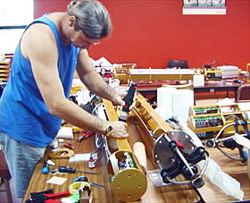|
Hot Topics: Autonomous Hydrophone Array (AHA) - Monitoring Volcanic and Tectonic Processes on the Mid-Ocean Ridge Looking for new volcanic eruptions on the global mid-ocean ridge and understanding when and where eruptions take place is one of the most exciting developments in marine geology and geophysics. Volcanoes, earthquakes and other seismic events are the primary forces that shape the Earth and rearrange the tectonic plates that make up the continents and ocean. Matt Fowler, a NOAA engineer, works on a hydrophone, or “Haru”phone, before it is deployed in the ocean. SOSUS was installed by the US Navy beginning in the mid-1950s for classified antisubmarine warfare and surveillance during the Cold War. SOSUS consists of groups of hydrophones that “hear” and record sound waves generated by seismic events, submarines, or whales, for example. The hydrophones are connected by undersea communication cables to facilities on shore. Individual hydrophone arrays are installed primarily on continental slopes and seamounts at locations that are unobstructed by seafloor features that would block sound wave transmission across large areas of the ocean. In October of 1990, the Navy gave NOAA access to SOSUS arrays in the North Pacific to monitor oceanic phenomena of environmental or scientific interest. Data collection systems developed by NOAA’s VENTS Program began operating in August of 1991. Acoustic signals from the north Pacific Ocean are monitored and recorded at NOAA’s Pacific Marine Environmental Laboratory (PMEL) facility in Newport, Oregon. This is the nation’s primary facility for continuously monitoring low-level seismicity in the northeast Pacific and for detecting volcanic activity along the mid-ocean ridge, as it is happening. The system demonstrated that it could successfully listen to eruptions taking place on the Juan de Fuca and Gorda Ridges using SOSUS. To expand the system's listening capabilities, our colleagues at the NOAA’s Hatfield Marine Center, in Newport, Oregon, under the direction of Dr. Chris Fox, figured out how to put self-recording hydrophones into the ocean at six locations in the Eastern Pacific Ocean, so that they can “hear” when eruptions on the mid-ocean ridge crest take place. In May of 1996, this array of autonomous hydrophones began long-term monitoring
of portions of the mid-ocean ridge in the central equatorial Pacific (the East
Pacific Rise and Galápagos Ridge). The Autonomous Hydrophone Array (AHA)
consists of six hydrophones spaced many hundreds of kilometers apart. These hydrophones
have been nicknamed “Haru”phones after Haru Matsumoto, the NOAA
engineer who developed them.
|
|
© 2010 Dive and Discover™. Dive and Discover™ is a registered trademark of Woods Hole Oceanographic Institution
|
|

